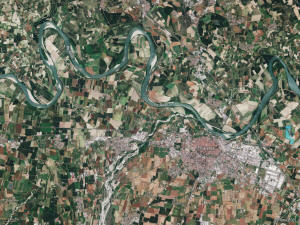Climate risks dwarf Europe's energy crisis, space chief warns
 Send a link to a friend
Send a link to a friend
 [August 13, 2022]
By Tim Hepher [August 13, 2022]
By Tim Hepher
PARIS (Reuters) - The head of the European
Space Agency (ESA) has warned economic damage from heatwaves and drought
could dwarf Europe's energy crisis as he called for urgent action to
tackle climate change.
Director General Josef Aschbacher told Reuters successive heatwaves
along with wildfires, shrinking rivers and rising land temperatures as
measured from space left no doubt about the toll on agriculture and
other industries from climate change.
"Today, we are very concerned about the energy crisis, and rightly so.
But this crisis is very small compared to the impact of climate change,
which is of a much bigger magnitude and really has to be tackled
extremely fast," he said.
He was speaking in an interview as heatwaves and floods generate
concerns over extreme weather across the globe.
More than 57,200 hectares have been swallowed by wildfire in France this
year, nearly six times the full-year average.
In Spain, a prolonged dry spell made July the hottest month since at
least 1961.
Utah's Great Salt Lake and Italy's Po River are at their lowest recorded
levels. France's Loire is now on the watch list.
On Tuesday, Britain issued a new amber "Extreme Heat" warning.

That follows record temperatures above 40 degrees Celsius (104
Fahrenheit) that placed a renewed focus on climate risks at July's
Farnborough Airshow in southern England, where Aschbacher said the issue
was humanity's biggest challenge.
"It's pretty bad. We have seen extremes that have not been observed
before," Aschbacher told Reuters this week.
Soaring air temperatures are not the only problem. The Earth's skin is
getting warmer too.
Aschbacher said ESA's Copernicus Sentinel-3 satellite series had
measured "extreme" land surface temperatures of more than 45C in
Britain, 50C in France and 60C in Spain in recent weeks.
Land surface temperature drives air circulation.
"It's really the whole ecosystem that is changing very, very fast and
much faster than what scientists expected until some years ago," he
said.
"It is drought, fires, intensity of storms, everything coupled together,
which are the visible signs of climate change."
As changes in temperature also become more marked, winds become stronger
and unleash harsher storms.
"Typhoons are much more powerful than they used to be in terms of wind
speed and therefore damage," Aschbacher said.

[to top of second column]
|

A Copernicus Sentinel-2 satellite image
shows Po River water levels in northern Italy on June 15, 2021. The
image is part of a three-part time series of the Po Valley showing
the shrinking of the river between 2020 and 2022, when water levels
hit a record low. Courtesy of European Union, Copernicus Sentinel-2
Imagery/Handout via REUTERS

BREXIT FUNDING GAP
The Austrian scientist was named head of Paris-based ESA last year
after leading the 22-nation agency's Earth observation work
including Copernicus, which ESA says is the world's largest
environmental monitoring effort, co-led by the European Union.
Together, the programme's six families of Sentinel satellites aim to
read the planet's "vital signs" from carbon dioxide to wave height
or temperatures of land and oceans.
Copernicus Sentinel-2 satellite images taken on roughly the same day
in June between 2020 and 2022, released by ESA, show how the
drought-stricken Po - whose plains sustain a third of Italy's
agriculture - has retreated to expose broad sandbanks.
But the programme faces a Brexit funding gap of 750 million euros
($774 million) needed to help develop a second generation of
satellites that Britain was to have contributed via the European
Union and whose fate is now under discussion.
After leaving the EU last year, Britain remains a member of ESA and
its 170-million-euro direct contribution is unaffected.
"We do still need the 750 million to complete development of this
second generation of satellites," Aschbacher said.
"And yes, that is certainly an issue for climate monitoring globally
but (also) for Europe in particular, because many of these
parameters are aiming at priorities for Europe."
A funding package for Earth observation worth an estimated 3 billion
euros will be discussed by ESA ministers in November.

Aschbacher dismissed what he called two myths voiced by critics who
question the international climate drive.
"The first is that people think one can wait and by waiting somehow
we will tough it out," he said. "The second is that it will cost a
lot of money to deal with climate change ... and affect the poorest
people, and we shouldn't do it," he said, adding that failing to
heed warnings like this year's weather crisis could cost hundreds of
trillions of dollars this century.
"Of course, you always have weather fluctuations ... but never of
this magnitude. There is no doubt in my mind that this is caused by
climate change," Aschbacher told Reuters.
($1 = 0.9685 euros)
(Reporting by Tim Hepher Additional reporting by Joey Roulette;
Editing by Mark Potter)
[© 2022 Thomson Reuters. All rights
reserved.]
This material may not be published,
broadcast, rewritten or redistributed.
Thompson Reuters is solely responsible for this content. |